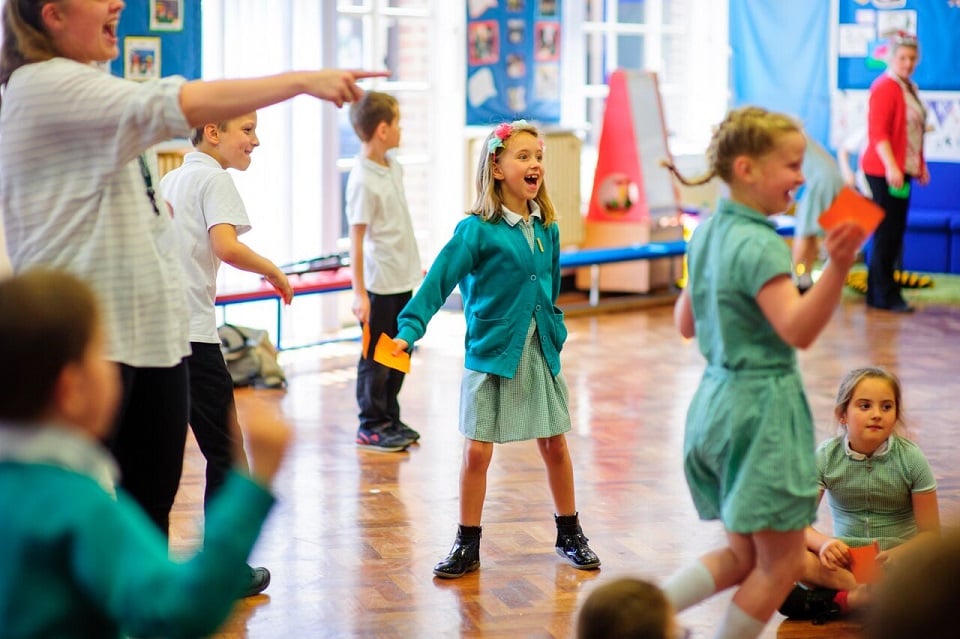
Pupils learning about maths through dance
Putting the arts back into the classroom
A new cultural curriculum in Bristol aims to reverse the decline in arts education. Phil Castang explains how the creative arts can enrich the teaching of STEM subjects.
Bristol often appears in lists of top destinations to visit and places to live. When colleagues visit the city from other parts of the UK, they always comment on how rich and vibrant the cultural scene is. It’s undoubtedly a key driver in Bristol’s success and positioning as a city.
But despite the obvious popularity and ubiquity of arts and culture in Bristol, many of our schools feel forced to relegate the position of creative arts subjects in the curriculum in favour of STEM subjects (science, technology, engineering and maths). Furthermore, schools are reducing funding for cultural enrichment at the very time they should be increasing it.
We have had positive feedback from the student teachers delivering the lesson plans about how liberating this way of teaching is
They are pushing dance, drama, music and art into paid-for, after-hours sessions, a situation which is compounded by the implementation of the English Baccalaureate (EBacc) that requires students to study English, maths, a language, science and history or geography at GCSE.
This is likely to exacerbate an existing trend of decline in arts education. If we take music as an example, according to The Economist (1 March 2018) the UK’s music industry is worth £4.4bn each year, yet the number of music GCSE students has fallen to its lowest level since 2007, at just 5.5% of the overall pupil population.
A cultural curriculum
Arts education and delivering results in STEM do not need to be mutually exclusive. In response to a lack of curriculum time being devoted to arts education, Bristol Music Trust is working with partners to pilot the Bristol Cultural Curriculum. Developed in cooperation with artists and teachers, it combines creative arts and STEM subjects, putting arts right back on the teaching agenda and enriching the classroom experience for students and teachers alike.
In partnership with Bristol Old Vic (drama), Chango Music (music), Theatre Bristol (dance), Room 13 (art) and teachers from E-ACT Multi Academy Trust, which runs four schools in Bristol, 72 tailored lesson plans covering 300 activities have been created. They give teachers adaptable resources that use the creative arts to teach STEM subjects.
As an example of how the subjects are being combined, power dynamics in engineering are demonstrated through the shift of power between two pupils dancing. In another lesson plan, the physiological mechanisms of the voice box and diaphragm are explained through performing poetry and song, and mathematical formulas are taught using musical instruments to decode a 'mysterious alien language'.
Evaluation and refinement
To properly evaluate the impact of the programme, we’re working with the education department of the University of the West of England (UWE), whose trainee teachers are piloting the lesson plans on placements in schools across Bristol. This has provided us with vital feedback as to how the plans are working in practice, helping to further refine and evaluate the programme before the curriculum resources are made available from September.
UWE is also embedding the programme as a teaching model in its initial teacher training degree course. That means when students go on to teach anywhere in the country, they will be taking the teaching principles into schools as part of their practice, enabling creative and critical thinking, skills that are vital to the economy.
We are optimistic that this is a transferrable model that could become a benchmark of best practice in keeping creative arts subjects at the core of a well-rounded education. We have had positive feedback from the student teachers delivering the lesson plans about how liberating this way of teaching is, allowing creative expression while being able to fulfil the curriculum demands.
Careers and creativity
We hope this will also inspire students to continue to seek careers in the creative industries, which are so vital to a city like Bristol. The idea that a career in the arts is somehow less stable than any other job must now surely be redundant. In his book Rise of the Robots: Technology and the Threat of a Jobless Future, author Martin Ford speaks about what jobs will be safe from technological advances and automation. Ford states that the safest, most resilient jobs will involve “genuine creativity, such as being an artist”. The creative arts offer meaningful employment pathways, but only if people see them as an option. That starts at school.
And aside from the intrinsic benefits of experiencing and participating in arts subjects at school there are numerous cognitive, social and health benefits. These are well documented and tangible. And they extend to the whole school.
Schools are facing enormous cuts due to the government’s new school funding formula (£32m in Bristol alone), and there is great pressure on the curriculum due to the implementation of the EBacc, but I would argue that the creative arts offer a path towards excellence.
Arts subjects provide a way for children with boundless imagination to find focus and purpose, and for more academic children, a way to excel through deep thinking and creativity. Schools and multi-academy trusts need to see the connection between creative arts subjects, school improvement and an enriched education for pupils.
Phil Castang is Director of Creative Learning and Engagement at Bristol Music Trust.
www.bristolplaysmusic.org
The Cultural Curriculum has been supported by funding from the Paul Hamlyn Foundation and will be made available via the Bristol Plays Music website later this summer.
Join the Discussion
You must be logged in to post a comment.